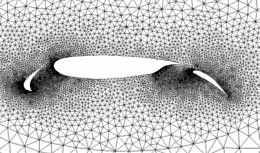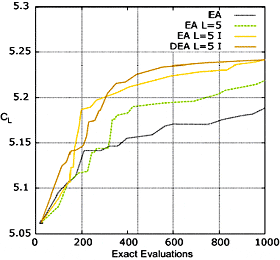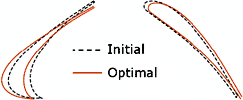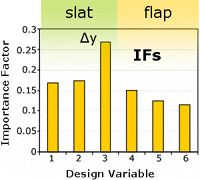Isolated Airfoil
Shape Optimization
Positioning of the
slat & flap of a
3-element airfoil
Optimal Airfoil
Shapes at different
operating conditions
Combined Cycle
Power Plant
Optimization
Positioning of the slat & flap of a 3-element airfoil
EASY used for the computation of the optimal positioning of the slat and flap of a three-element airfoil, operating at M_inf=0.12, a_inf=13.18deg). The target was to maximize the lift of entire configuration. An inviscid flow solver (Euler equations) with unstructured grids was used (a typical grid around the three-element airfoil is shown). This problem involves six design variables (three for the slat and three for the flap: x-displacement, y-displacement and a rotation angle).
 |
 |
Since a costly CFD tool was used for the evaluation of any candidate solution, EASY offers the possibility of reducing the computing cost through resorting to a surrogate model, such as artificial neural networks (ANNs). An Inexact Pre-Evaluation (IPE) phase is automatically activated using EASY. Further improvement can be obtained using the so-called Importance Factors (IFs), i.e. quantities showing the relative importance of each design variable; these are computed on line and used by the ANN, improving thus its prediction capabilities. The next figure demonstrates a typical gain in CPU time or, equivalently, in number of evaluations required to achieve a certain cost, compared to the convergence of a standard stand-alone evolutionary algorithm (black line). The green line is the convergence of Evolutionary Algorithms with ANNs, yellow line is with ANNs and IFs and the brown line is Distributed Evolutionary Algorithms with ANNs and IFs. All these cases used EASY with different optimization parameters. L stands for the number of exact evaluations per generation. In the case of the standard evolutionary algorithms L is equal to the population size (number of offspring). The right part show the initial and optimal locations of the slat and flap.
 |
 |
A by-product of the use of EASY is the knowledge of the Importance Factor values, indicating the relative importance of each design variable. In this application, the y-displacement of the slat seems to play a key role in the design process.
 |
Design Variable | Initial | Optimal |
| 1: Slat Rot. Angle (deg) | 28.1 | 28.02 | |
| 2: Slat ?x | -0.020 | -0.0308 | |
| 3: Slat ?y | 0.0269 | 0.0198 | |
| 4: Flap Rot. Angle (deg) | -37 | -36.96 | |
| 5: Flap ?x | 0.020 | 0.0202 | |
| 6: Flap ?y | 0.0249 | 0.0247 |